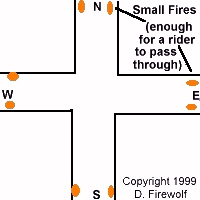(I orginally wrote this in 1999. I'll be updating this pretty soon with a bibliography, once I re-find the books I used - they're here somewhere. Most of the info here is reliable, coming from books strictly on Celtic myth. However, the folk custom needs validating since it came from a D.J. Conway book.)
Epona
Lately, it seems that Epona is coming back into Her own with the growing popularity of the internet. Most people identify with Her through Her connection with horses - She is the protector of them, after all - but most people don't seem to be aware of all Her aspects.
Epona seems to have her beginnings in Gaul and then spread from the western coast of Ireland to the lands of Bulgaria. In Ireland, She was paired with Horned One, Cernunnos - the Mare and Stag being two potent fertility symbols. In other places, She was paired with the thunder god Taranis - why, I don't know. She was and is also a 'domestic' deity, being a goddess of fertility; prosperity, abundance as well as the aforementioned horses and horse breeding.
Horses are such a part of Her, She is never depicted without them. She is always shown either standing beside a horse, usually a mare, or is riding sidesaddle. (Sidesaddle is just that - instead of sitting with a leg on each side of the horse, one leg is hooked around a horn on the saddle and the foot of the other leg is inserted into the stirrup. This was thought to be more 'ladylike' not so long ago.) Other symbols She is sometimes depicted with are a cornucopia, ear of corn or a key.
In ancient times, horses weren't always so easy to come by. In Europe, they were considered 'prestige' animals. Still, they did all the usual jobs - mostly by providing transportation, either by carrying humans directly or pulling carts.
The Celts revered the horse for several things: its beauty; speed, bravery and vigor in the sexual arena. In time, the horse came to symbolize the warrior-elites - the aristocracy - in Celtic society. They thought so much of their horses that even their greatest horse deity's name incorporates the very word - epos - in Her name.
Epona was the only deity, Celtic or otherwise, that was adopted by the Romans without changes. Usually when they found a deity that they liked, they (ahem) appropriated it and gave it the name and attributes of the Roman deity that it most closely resembled. Even poor Isis suffered - even though She got to keep Her name, believe me when I tell you that She got stuck with the Roman ideals for a deity...
Anyway, getting back on topic here...
The Roman calvary adopted Epona wholeheartedly, giving Her a feast day of December 18. This is where part of Epona's war attributes come in. They looked to Her as a protector of both horse and rider - especially the officers who served in the areas of the Danube and Rhine. Celtic warriors may have also called on Her to protect them and their horses - they used two - horse teams to pull light and fast chariots in battle.
Epona was also a dream goddess - Her specialty seems to have been (be?) nightmares. She was even immortalized in a painting by Henry Fuseli's painting, The Nightmare. Many a child in Ireland were told to be good or Epona would visit them with horrific nightmares. A folk custom from Western Ireland seems to confirm this:

Just before dawn, find a place where two roads cross each other - they must be perfectly oriented to the four directions (north, south, east and west). Light eight small fires - one for each side of the roads and be sure to leave enough room for a horse and rider to pass through. Next, play 'horsie' yourself - ride three times around the intersection on a besom (broom) and then the fun begins. Sit and wait for a dark lady dressed in black riding a horse; fleeing west from the approaching rays of morning. It is said to be Epona, returning from Her night of dispensing dreams.
Home
This page and graphics is © 1999-2004 by Dawn Firewolf, All Rights Reserved.